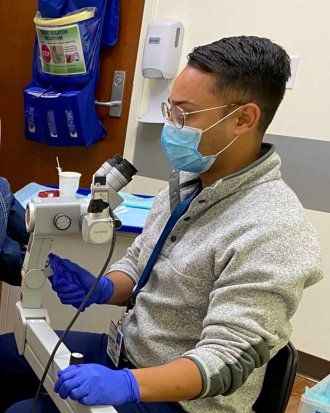Results from a national study led by UC San Francisco informed the first guidelines at the federal level in the U.S. to detect and treat anal cancer precursor lesions in people with HIV to reduce the risk of developing anal cancer.
The guidelines were published on July 9 by a panel of experts in HIV care, utilizing findings from the Anal Cancer/HSIL Outcomes Research (ANCHOR) trial led by Joel M. Palefsky, MD, a professor of medicine in the UCSF Infectious Disease Division. The ANCHOR study was funded by the National Cancer Institute (NCI) of the National Institutes of Health (NIH) and conducted by the AIDS Malignancy Consortium.
The ANCHOR trial, conducted at 25 clinical sites around the country and published in the New England Journal of Medicine in 2022, found that routine screening for and removal of precancerous anal lesions could significantly reduce the risk of anal cancer, in much the way that cervical cancer is prevented in women.
"Anal cancer is a very bad disease, and we now have the tools to significantly reduce the risk," said Palefsky, a globally recognized expert on anal cancer. "With this new recommendation, we hope that screening for anal cancer becomes a routine procedure in the care of people with HIV."
Risk of anal cancer is high in people with HIV
While anal cancer is rare within the general population, cases have been rising, and among people living with HIV, it is the fourth most common cancer.
I strongly encourage people with HIV to discuss anal cancer screening with their primary care providers."
For people with human papillomavirus (HPV), a common sexually transmitted virus, coinfection with HIV can increase the risk of developing anal cancer. "Men with HIV who have sex with men and transgender women with HIV are the groups at the highest risk of anal cancer," note the new guidelines.
Anal cancer may have no symptoms in its early stages, and patients may mistake it for hemorrhoids. By the time it's diagnosed, it may have spread.
Under the new guidelines, if high-resolution anoscopy is available, certain adults with HIV - starting at age 35 for men, and transgender women, who have sex with men; and starting at 45 for women and men who do not have sex with men - should undergo screening for anal cancer precursor lesions with laboratory testing of an anal swab sample, and a digital anorectal examination to feel for changes that might indicate the presence of a cancer.
"The screening procedure is quite simple," Palefsky said. "If the screening test is positive, the next step of the evaluation is HRA. If an anal cancer precursor lesion is found at HRA, it is then treated to reduce the risk of progressing to cancer."

If HRA is not available, people with HIV who are of screening age should still have an annual rectal exam and be referred for standard anoscopy if the screen is positive. Those who have pain, bleeding or masses, or who show signs of anal cancer should undergo standard anoscopy. Palefsky added that symptomatic people under 35 with HIV should also undergo standard anoscopy.
"I strongly encourage people with HIV to discuss anal cancer screening with their primary care providers," he said.
In 1991, Palefsky established the world's first clinic focused on prevention of anal cancer, the UCSF Anal Neoplasia Clinic Research and Education Center.
The recommendations were developed by the U.S. Department of Health and Human Services' Panel on the Prevention and Treatment of Opportunistic Infections in Adults and Adolescents with HIV, which is composed of experts in HIV care. The panel is a working group of the NIH Office of AIDS Research Advisory Council, in collaboration with the Centers for Disease Control and Prevention, the HIV Medicine Association and the Infectious Diseases Society of America.






